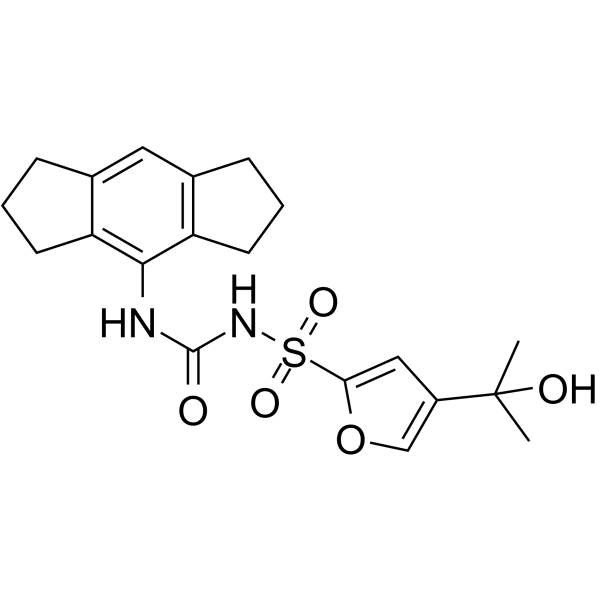| Description |
MCC950 is a potent and selective NLRP3 inhibitor with IC50s of 7.5 and 8.1 nM in BMDMs and HMDMs, respectively.
|
| Related Catalog |
|
| Target |
IC50: 7.5 nM (NLRP3, in BMDMs), 8.1 nM (NLRP3, in HMDMs)[1]
|
| In Vitro |
MCC950 blocks canonical and non-canonical NLRP3 activation at nanomolar concentrations. MCC950 specifically inhibits NLRP3 but not AIM2, NLRC4 or NLRP1 activation. The effect of MCC950 on NLRP3 inflammasome activation is tested in mouse bone marrow derived macrophages (BMDM) and human monocyte derived macrophages (HMDM). The IC50 of MCC950 in BMDM is approximately 7.5 nM, while in HMDM it has a similar inhibitory capacity (IC50=8.1 nM). MCC950 also dose dependently inhibit IL-1β but not TNF-α secretion.MCC950 specifically blocks caspase-11-directed NLRP3 activation and IL-1β secretion upon stimulation of the non-canonical pathway. NLRC4-stimulated IL-1β and TNF-α secretion (as activated by Salmonella typhimurium) are not inhibited by MCC950 even at a concentration of 10 µM. MCC950 does not inhibit caspase-1 activation or IL-1β processing in response to S. typhimurium. The expression of pro-caspase-1 and pro-IL-1β in cell lysates is not substantially affected by MCC950 treatment[1].
|
| In Vivo |
MCC950 reduces Interleukin-1p (IL-1β) production and attenuates the severity of experimental autoimmune encephalomyelitis (EAE), a disease model of multiple sclerosis. Pre-treatment with MCC950 reduces serum concentrations of IL-1β and IL-6 while it does not considerably decrease the amount of TNF-α. Treatment of mice with MCC950 delays the onset and reduced the severity of EAE. Intracellular cytokine staining and FACS analysis of brain mononuclear cells from mice sacrificed on day 22 shows modestly reduced frequencies of IL-17 and IFN-γ producing CD3+ T cells in MCC950 treated mice in comparison with PBS-treated mice. IFN-γ and particularly IL-17 producing cell numbers are also reduced in both the CD4+ and γδ+ sub-populations of CD3+ T cells[1].
|
| Cell Assay |
BMDM are seeded at 5×105/mL or 1×106/mL, HMDM at 5×105/mL and PBMC at 2×106/mL or 5×106/mL in 96 well plates. The following day the overnight medium is replaced and cells are stimulated with 10 ng/mL LPS from Escherichia coli serotype EH100 (ra) TLRgrad for 3 h. Medium is removed and replaced with serum free medium (SFM) containing DMSO (1:1,000), MCC950 (0.001-10 µM), glyburide (200 µM), Parthenolide (10 µM) or Bayer cysteinyl leukotriene receptor antagonist 1-(5-carboxy-2{3-[4-(3-cyclohexylpropoxy)phenyl]propoxy}benzoyl)piperidine-4-carboxylic acid (40 µM) for 30 min. Cells are then stimulated with inflammasome activators: 5 mM adenosine 5’-triphosphate disodium salt hydrate (ATP) (1 h), 1 µg/mL Poly(deoxyadenylic-thymidylic) acid sodium salt (Poly dA:dT) transfected with Lipofectamine 200 (3-4 h), 200 µg/mL MSU (overnight) and 10 µM nigericin (1 h) or S. typhimurium UK-1 strain. Cells are also stimulated with 25 µg/mL Polyadenylic-polyuridylic acid (4 h). For non-canonical inflammasome activation cells are primed with 100 ng/mL Pam3CSK4 for 4 h, medium is removed and replaced with SFM containing DMSO or MCC950 and 2 µg/mL LPS is transfected using 0.25% FuGENE for 16 h. Supernatants are removed and analysed using ELISA kits. LDH release is measured using the CytoTox96 non-radioactive cytotoxicity assay[1].
|
| Animal Admin |
Mice[1] C57BL/6 mice are immunized subcutaneously with 150 µg of MOG peptide 35-55 emulsified in CFA containing 4 mg/mL (0.4.mg/mouse) of heat-killed MTB. Mice are injected i.p. with 500 ng pertussis toxin (PT: kaketsuken) on days 0 and 2. MCC950 is administered i.p. to mice (10 mg/kg) at induction of the disease, day 0, 1 and 2 and every 2 days thereafter. Control mice are administered vehicle (PBS) at the same time points. Mice are observed for clinical signs of disease daily (unblinded). Disease severity is scored as follows: no clinical signs, 0; limp tail, 1; ataxic gait, 2; hind limb weakness, 3; hind limb paralysis, 4; and tetra paralysis, 5.
|
| References |
[1]. Coll RC, et al. A small-molecule inhibitor of the NLRP3 inflammasome for the treatment of inflammatory diseases. Nat Med. 2015 Mar;21(3):248-55. [2]. Gan W, et al. The SGK1 inhibitor EMD638683, prevents Angiotensin II-induced cardiac inflammation and fibrosis by blocking NLRP3 inflammasome activation. Biochim Biophys Acta. 2017 Oct 3;1864(1):1-10. [3]. Zhang XY, et al. Propofol Does Not Reduce Pyroptosis of Enterocytes and Intestinal Epithelial Injury After Lipopolysaccharide Challenge. Dig Dis Sci. 2018 Jan;63(1):81-91. [4]. Qi Y, et al. NLRP3-dependent synaptic plasticity deficit in an Alzheimer's disease amyloidosis model in vivo. Neurobiol Dis. 2018 Feb 23;114:24-30.
|
